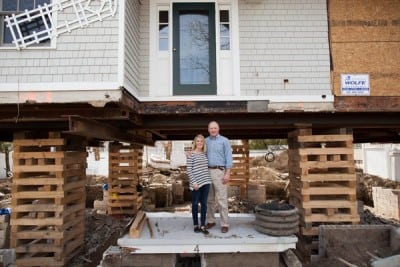Flood Elevation
What You Need To Know Before, During, and After
Flood elevation requirements are changing as a result of storms, such as hurricane Irene, tropical storm Lee, and Superstorm Sandy that inflicted severe wind and water damage to many structures along the Northeastern US coast and farther inland. Storms with similar force and scope are expected to become more widespread in the future, so elevating your home in preparation for possible flooding is a wise decision you’ll be glad you planned for ahead of time.
As a homeowner, you recognize that it’s wise to be aware of what to expect before, during, and after your home is lifted. Raising your home to meet flood elevation requirements is a large undertaking and requires proper planning and expert insight. In fact, our own project manager Jamin Buckingham was asked to offer his expertise as a reviewer for FEMA’s Engineering Principles and Practices—a guide for retrofitting flood-prone residential structures. Our insight and knowledge will guide you along every step of the process. The government also has publications and online tools that you might find helpful.
The Federal Emergency Management Agency (FEMA) published guidelines for elevating your house that will help you understand the benefits of home elevation, including considerations for deciding how high to elevate your home, explanations of various structural lifting methods, and many diagrams that describe the process. If you are considering lifting your home, it is definitely worth your time to read this important information.
Another useful tool is the National Flood Insurance Program’s online flood damage estimator. This tool will help you gauge what it will cost to recover from future flood damage to your home, and how that cost compares to the cost of raising your home. Raising your home above the flood elevation and eliminating the possibility of future flood damage typically makes the most sense for homeowners who are comparing the costs.
Next, we would like to walk you through a few questions that address the Before, During, and After of lifting your home.
What to Consider Before the Lift
Factors That Affect the Lifting Cost
- Size and shape of the house
- Structural material of the house (frame, block, brick, or stone)
- Working room underneath and around the house
Do I Need an Elevation Certificate?
- Communities are encouraged to use FEMA’s Elevation Certificate. The elevation certificate ensures compliance with local flood plain ordinances.
- If you live in a flood zone, each locality has its own FEMA flood hazard map. Find yours to learn what FEMA’s flood elevation recommendations are for your town.
- It’s good to know the 100-year flood plain for your property; it might be a factor in deciding how high to lift the structure to ensure you are protected well into the future.
How Am I Going to Pay For This?
The National Flood Insurance Program, established in 1968, underwrites most flood insurance agencies. Communities must adopt and enforce floodplain regulations and ordinances in order to participate in the NFIP. In exchange, FEMA makes flood insurance available to residents within these communities. If you have insurance, your insurer might cover the cost, either completely or partially, for your house to be lifted. Check with your local borough or township office to see if they have applied for funding on residents’ behalf. It is best to call your local township office to find out if you qualify for assistance or if the township has funds available to you.
What Else Should I Plan For?
Wolfe House & Building Movers specializes in the lifting and moving of your building only. You will need to contact a general contractor to coordinate and complete all other aspects of your project, such as masonry, carpentry, and utility work. Engineered foundation drawings and building permits will most likely be required as well. A certified contractor will be able to assist you with obtaining those documents.
What Can I Expect During and After the Lift?
During
- To elevate your home, we use the latest, most advanced hydraulic lifting equipment in the structural moving and raising business. The Unified Hydraulic Jacking System synchronizes pressure to ensure an even lift across the entire structure. This helps to keep cracking and other minor damage to a minimum (or eliminates it completely).
- Every structural lift we perform will have an expert crew on site led by an experienced project manager.
- Most simple residential lifting projects can take as little as one to three days to complete.
After
- After the house is set onto the new foundation, your general contractor will work with you to finish all other aspects of the project.
- We will work with you to ensure you’re satisfied with the house lifting portion of your project.
Contact Wolfe House & Building Movers
Please use our contact form or give us a call at 610-488-1020 to request a free quote.

